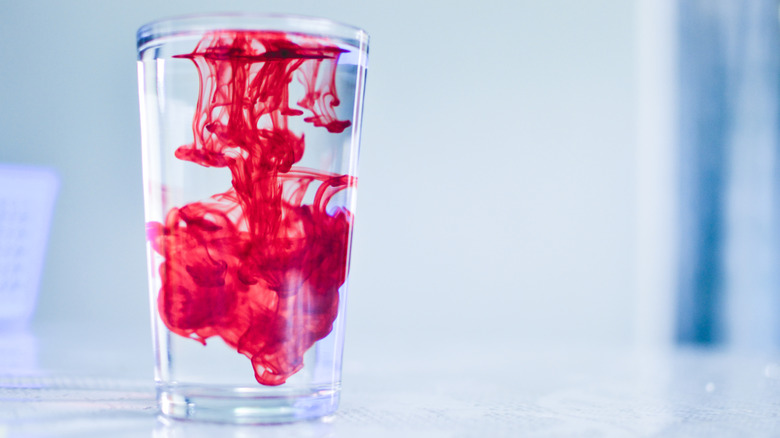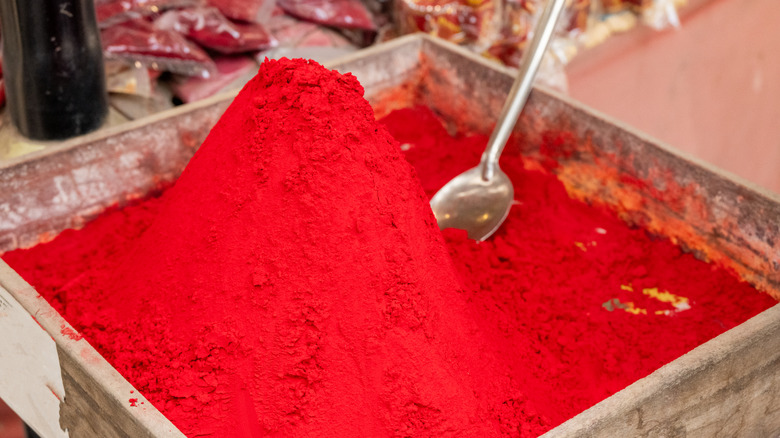What's The Difference Between Red 40 And Red 40 Lake?
If you read food labels, you've probably seen both "red 40" and "red 40 lake" show up a lot. While the names are nearly identical, they aren't the same thing. Since the distinction mainly matters to food manufacturers, it's barely explained to consumers, and the question comes up most often for people with food allergies, dietary restrictions, or a general curiosity about what's in their processed foods. Both dyes are made from the same base compound (allura red AC), but their chemical forms and uses differ.
Red 40 is a water-soluble dye that's synthesized from petroleum, giving a bright, reliable red color to foods and drinks. It dissolves easily in water, which means it's ideal for sodas, sports drinks, yogurts, and any food that's wet or liquid-based. The "lake" form, by contrast, is created through a process that binds the dye to an insoluble mineral salt, usually aluminum; this makes it a fine, stable powder that doesn't dissolve in water, and is more frequently used in candy and gum.
Manufacturers choose between red 40 and red 40 lake based on how the dye will behave: How it dissolves, how it holds color, and how it coats a surface. For the person buying a processed snack or a drink, the distinction is almost always only technical. It affects the color, consistency, and shelf life, even if the ingredient list doesn't spell out why.
The history of eating red
Long before red 40, cooks and manufacturers used whatever red pigments they could find. In the ancient world, the answer was often mineral or plant-based: Pomegranate, beet juice, or spices like annatto and paprika. Unfortunately, these early colorings were unstable. Sunlight faded them, heat changed their tone, and their flavor wasn't always neutral. Carmine (also known as cochineal) offered a natural but labor-intensive alternative to early food dyes during the late 19th and early 20th centuries — before the rise of synthetic dyes.
Red no. 2 (amaranth) and red no. 3 (erythrosine) became widely used through the 1960s. Eventually, concerns over potential toxicity and cancer risk led to lowered use along with bans and replacements, although some snacks still contain red dye no. 3. Red 40 was introduced in the 1970s, becoming the preferred synthetic red dye because it was more stable, vivid, and, according to regulatory bodies, safer at approved levels. Its manufacture from petroleum is a detail rarely highlighted on packages, but it means the dye is cheap, consistent, and easily produced at scale.
Petroleum-derived reds don't fade, don't alter flavor (much), and don't change under bright lights or high heat. For manufacturers, it means shelf-stable products that remain bright, juicy red — even after months or years in a warehouse. Petroleum is already produced at massive scale, so using its byproducts is inexpensive. That kind of cheap reliability isn't possible with natural pigments, and it's helped drive the use of synthetic coloring into nearly every processed food aisle.
Humans love bright red
If brightly colored foods seem more appealing, it's not an accident. Modern food dyes, including red 40 and red 40 lake, are added to catch the eye and signal sweetness, flavor, or fun, especially in snacks and cereals marketed to children. Studies show that people often perceive more vibrant foods as tastier or fresher, even when the flavor is unchanged. In other words, the color isn't really there for taste experience, nutrition, or safety: It's to shape desire and drive sales.
Of course, that marketing strategy has drawn controversy. Synthetic dyes have been debated for decades, with some researchers and consumer groups raising concerns about possible links to hyperactivity and physiological allergic reactions. Large studies have not found consistent risks at typical exposure levels, but some countries have begun requiring warning labels, or banned certain dyes as a precaution. In the U.S., Red 40 remains widely used and approved by the FDA as of July 2025.
For most shoppers, the difference between red 40 and red 40 lake is invisible. The real question may be whether food needs this much color at all, and who benefits from its presence. Removing the dye would change the look of the grocery aisle, but most flavors and nutrients would stay the same. The value of artificial red, in the end, is less about eating and more about perceiving. After all, would a hot Cheeto (the brand's best flavor) taste as hot if it were any other color?


